Founded in 2004 by George Petersen and presented since 2015 by the NAMM MUSEUM of Making Music, the TECnology Hall of Fame honors and recognizes audio products and innovations that have made a significant contribution to the advancement of audio technology. Inductees to the TECnology Hall of Fame are selected by a panel of more than 50 recognized audio experts, including authors, educators, engineers and other professionals. Products or innovations must be at least 10 years old to be considered for induction.
Past Inductees: 2015 | 2016 | 2017 | 2018 | 2019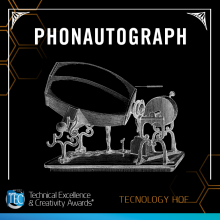
Imagine that some two decades before Thomas Edison (widely regarded as the “inventor of recorded sound”) you had created a system for recording sounds, music and the human voice. Well, this is exactly what happened to Parisian printer and experimenter Edouard-Léon Scott de Martinville, who devised such a system in 1857.
The device, which he called the phonoautograph, used acoustic transducers that were similar to the recording/playback horns used by Edison and fellow audio pioneer Emile Berliner in their phonograph and gramophone systems). The narrow end of Scott de Martinville’s phonoautograph horn ended in a flexible diaphragm that reacted to sound waves, and vibrated an attached bristle or fine feather quill in response to the audio. To capture the audio output in a visible form, a sheet of paper covered with a thin layer of smoke particles rotated against the feather tip, with the result being a “drawing’ of the waveform. Once on paper, these “phonautograms” could be transferred onto photographic plates to create a permanent versions for later study of the wave motion.
And there’s the rub — Scott de Martinville was mainly interested in creating a tool for studying visual analogies of various sound waves, and had no interest in creating an audio playback system.
Over the ensuing years, he continued to improve the phonautograph devices, and collected numerous “recordings” of various sources — natural sounds, spoken voices, singing and more. Unfortunately, with no means of playing back the phonautograms, and Scott de Martinville’s work remained a interesting novelty — a mere footnote in the history of recorded audio.
Flash forward 150 years into the future and a group of early-21st century researchers from the Lawrence Berkeley National Laboratories (Berkeley, California) wondered whether digital technology could unlock the hidden sounds from these captured waveforms. After some tweaking of some high-resolution scans of the printed waveforms — many of which had been locked away for decades — sounds from long ago began to emerge.
One phonautogram of particular interest was a voice singing part of “Au Clair de La Lune,” but not knowing the pitch (recording speed) of the original, there was no way of telling whether the performance was a child, man or woman. As luck would have it, another phonautogram happened to be a capture of a tuning fork, and from there, determining the correct pitch of the other recordings was a simple affair. As it turns out, the crude “Au Clair de La Lune,” recording was performed by a male voice — presumably Scott de Martinville himself. And so the mystery of the 150+ year-old phonoautograms was finally solved.
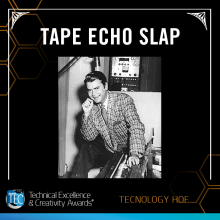
These days, creating new sounds in the studio often comes from simply grabbing the latest DSP plug-in or synth patch. But it wasn’t always so easy, and in the early days of studio production, producers and engineers were left to their own resources to make original sounds. One of the best examples of this came from the legendary Sam Phillips, one of the most influential producers in rock history. As owner of Memphis-based Sun Records, Phillips helped launch the careers of Elvis Presley, Johnny Cash, Jerry Lee Lewis and B.B. King, among others.
Besides employing innovative techniques such as close miking, Phillips was looking for a “sound” to define some of artists on his roster. Phillips began feeding channels into a second tape recorder and combining the delayed sound from that deck’s playback heads, resulting in a long echo similar to sound bouncing off the back wall of a venue, in a new process known as tape slap delay. By adjusting the playback speed of the second recorder, a variety of echo effects were possible. One of Phillips’ earliest examples of this was used on Elvis’ “Blue Moon of Kentucky,” and tape slap quickly became a part of defining the new rock ‘n’ roll genre.
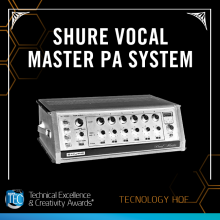
Once upon a time, the idea of a simple to use/hook up, fairly loud and relatively compact sound system was just a dream of many musicians and touring ensembles. Not that one could not be assembled — for example, a rig with an Altec 1567A tube mixer separate power amp and a couple speakers could be created, but it would be heavy and relatively expensive.
Unveiled in 1968, and designed for vocal reinforcement applications, the Shure Vocal Master P.A. was considered the “first complete portable sound system.” The line featured a combination of solid-state, six input, 100-watt powered Vocal Master mixers (with individual treble/bass controls and onboard spring reverb) matched to two 63x16x9-inch (HxWxD) floor-standing VA-300 column speakers. Of course, Shure microphones were optional, as was an external 100-watt Power Master power amplifier. This could take an output feed from the Vocal Master mixer and route it to additional column speakers — either to provide more volume for larger gigs, or simply to increase the horizontal dispersion for wider coverage.
The VA-300 enclosures each contained six speakers in all, with top- and bottom-mounted 10-inch woofers flanking four 8-inch cone drivers. The columns were offered in 16- and 32-ohm versions, so a single amp or mixer module could drive up to six speakers.
The reaction to the affordable Shure Vocal Master systems was an immediate hit. These found themselves in any number of applications, from touring bands to church and institutional installs to every conceivable type of portable public address need — school commencements, political rallies and more — in fact, anywhere a versatile rig could fit into a car trunk or station wagon.
Eventually, the need for systems that could stand up to the screaming stages of 60’s and 70’s rock took their toll, and the Vocal Master systems were retired from the Shure line. Yet even today, I am not entirely surprised to encounter a couple wall-mounted VA-300 columns in some venue somewhere.
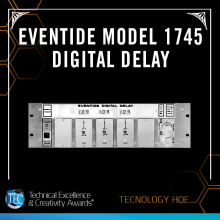
Founded in 1970 by inventor Richard Factor, studio owner Steve Katz and businessman/patent attorney Orville Greene, Eventide has since become a world leader in audio processing gear as well as its top-flight NexLog communications recorders for public safety, utilities, P25 and air traffic control operations. On the music/broadcast production side, the company is probably best known for its enormously successful Harmonizer® effects processor, with its first H910 model inducted into the TECnology Hall of Fame and the H3000 UltraHarmonizer getting the honor in 2016.
Launched in 1971, Eventide’s 1745 digital delay (its first digital product) offered two channels of independent delay from a single input. Initially designed for a Maryland-based public broadcaster, the original 1745 offered up to 200 milliseconds of delay through a hundred shift registers each with a then-massive memory capacity of 980 bits (!) each. The invention gave birth to several other models, including the improved 1745A and the 1745M — one of the first uses of RAM memory in an audio product.
The 1745M (the “M” stood for “memory”) had a single balanced line input wired to five expansion slots — each of which could be fitted with an independent delay line module, with the output of each routed to a separate XLR output for each. Eventually an option was added for the 1745M — this being a double-wide (two-slot) plug-in pitch change module and users could set up and customize their 1745M to fit their particular needs. One milestone for the 1745 was that its pitch module was the first such available product with a frequency response suitable for music production.
While the original 1745 and 1745A remain fairly rare, over the years, the 1745M has remained a popular studio item with bands such as Kiss and Tom Petty. In fact, superproducer/engineer Bruce Swedien had several 1745M delays (including one fitted with a pitch shift module) in his outboard rack used to mix Michael Jackson’s classic Thriller album.
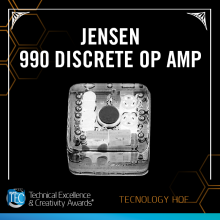
Known since the 1940’s in vacuum tube form (based on two 12AX7 dual triode tubes), op-amps are differential amplifiers with a wide range of applications in analog circuit design. By packaging the op-amp in a socketed design with discrete components, op-amps provided a convenient means of accomplishing amplification tasks from a single component package. In 1968, the (now-almost universal) 741 op-amp came out, which put the equivalent of a 20-transistor circuit into a tiny 8-pin monolithic integrated circuit chip. The cost savings to manufacturers was a huge draw, particularly for audio gear and IC op-amps were soon implemented into all types of pro and consumer gear.
The IC approach, while convenient, exhibited performance weaknesses compared to discrete component designs, particularly in critical professional audio applications, such as consoles and mic preamplifiers.
Deane Jensen, a design engineer for console companies such as Quad-Eight and API had been researching op-amp designs. In 1979, he published an AES Journal paper on his work on an improved approach to what would become the 990, a potted transistor module using all discrete components. The 990 exhibited a combination of low noise, low distortion, slew rate, stability and high output drive capabilities and that were hailed as a performance breakthrough in the pro community.
Jensen was also known for his world-class audio transformer designs, from his successful company Jensen Transformers, and while the 990 was not a huge moneymaker, Jensen was thrilled that these modules found and appreciative audience.
Sadly, Jensen passed away in 1989, and the 990 continues in production in a third-generation 990C made by the John Hardy Company. Today, Jensen Transformers continue being manufactured as a subsidiary of Radial Engineering.
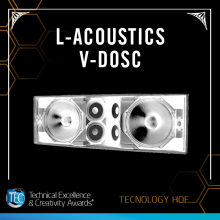
It wasn’t until 1992 when French company L-Acoustics introduced the V-DOSC, the first line array sound reinforcement loudspeakers, and changed the industry forever. Designed by company founder Dr. Christian Heil and his team, the system was based on the company’s Wavefront Sculpture Technology (WST) theory, which offered the first high-frequency device capable of creating a constant-phase planar output.
V-DOSC is an active full range 3-way loudspeaker enclosure that satisfies WST conditions when vertically arrayed. Each V-DOSC enclosure contains two direct radiating, bass reflex-loaded 15-inch low frequency transducers, four bass reflex-loaded 7-inch midrange frequency transducers that are mounted in a V-shaped acoustic lens configuration and two 1.4-inch exit, titanium diaphragm compression drivers that are coupled to individual, vertically-aligned DOSC waveguides. As a full-range system, the frequency response is 50 Hz to 18 kHz with less than ± 3 dB variation.
Complementing the V-DOSC enclosure is the dual-18 SB 218 subwoofer, which exactly matches V-DOSC’s 51.25-inch width and can be flown or ground-stacked to expand the system’s low-frequency performance down to 30 Hz.
Over the years, V-DOSC has been universally accepted on equipment riders for top touring artists and used in hundreds of installations worldwide.
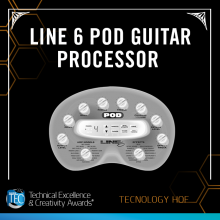
Throughout his career, Line 6 founder Marcus Ryle has rocked the industry, although he’s not exactly a household name. Prior to founding Line 6, Ryle ran Fast Forward Designs, a company whose name stayed in the background while it consulted on and designed some of the most influential products in the business, such as the Alesis ADAT (as well as accessories for the line including the BRC and numerous interfaces), various Alesis drum machines and more.
Line 6 unveiled its first lines of digital modeling guitar amplifiers in 1996. These were followed two years later by the enormously successful (and popular) Amp Farm plug-ins for Pro Tools users.
But also in 1998, to make sure that non-Pro Tools users could access amplifier modeling in an easy to use hardware format, Line 6 launched the POD. Revolutionizing guitar tone creation with its digital amp modeler, the POD quickly found its way into personal and professional studios. The first of its kind, the POD was affordable, and would go on to spawn multiple iterations, becoming a staple for guitarists in the studio or at home that continues to this day.

Mention the name Solid State Logic and images of huge, high-end, high-ticket mixers immediately come to mind. Yet in 2004, this supplier of world-class consoles unveiled a product that broke new ground in terms of performance and price. The AWS 900 takes the high-performance, 200k Hz analog electronics of SSL's XL 9000 console.
The board, which can operate as a straightforward 24×8 analog desk, features switchable SSL E or G Series EQ, assignable SSL dynamics, G Series stereo main bus compressor and 100mm moving fader automation.
The AWS 900’s monitoring capabilities are formidable, with facilities for controlling two sets of stereo speakers and two entire 5.1 rigs: mains and near-fields. The AWS 900 was also the first SSL console to feature high-impedance inputs for interfacing with direct instrument inputs. Pricing was $85,000 — definitely more than a Mackie 1604, but affordable by SSL’s big console standards. In fact, during the nominations phase for the 2005 TEC Awards, SSL tried to enter the AWS 900 into the small-format console category (it was the smallest console the company had made at that time), yet somehow a 185-pound, 57-inch wide mixer didn’t quite meet the criteria for a compact console and today, that category is limited to models weighing less than 60 pounds.
But what did set the AWS 900 apart from other SSL products of its time was its DAW controller functions. The 24-channel controls can be bank-switched to perform as traditional audio channels, DAW channels or — in groups of eight — a combination of both. Within the master section's DAW control panel, most of the workstation action occurs. The AWS 900 software communicates with DAWs via MIDI, is Mackie HUI-compatible and included templates for Logic, Nuendo and Pro Tools.
Even more impressive is the fact that the AWS 900 — in its newest generation — remains in production some 14 year later — an impressive accomplishment for any console design.
